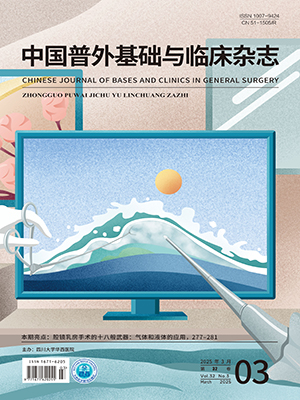Objective To investigate the effect of CO2 pneumoperitoneum on the tumor cell port site implantation in laparoscopic surgery.
Methods Male SpraqueDawley rats were intraperitoneally injected with gastric cancer cells (cell line SGC-7901). Continuous CO2 pneumo of 15 mm Hg or 30 mm Hg were established for 5 mins, 60 mins, 120 mins and 180 mins with the injection of different concentrations of tumor cells (104/ml, 106/ml respectively). Several samples of peritoneal washing served as positive control. All collecting dishes were incubated at 37℃ with 5% CO2 concentration for one week and then examined for the presence of tumor cell under microscope.
Results After one week of incubation, some of the dishes with continuous flow of CO2 gas (5 L/min) at pneumo 30 mm Hg for 60 mins or longer demonstrated tumor growth, and all peritoneal washing samples showed tumor growth, while other dishes showed negative.
Conclusion The research suggests that gastric cancer cells can cause port site implantation and the concentration of tumor cells, pneumoperitoneum pressure and duration may affect the occurrence of port site implantation. It may help to find a suitable way to prevent the port site implantation in operations.
Citation:
ZHANG Haobo,WANG Hao,ZHEN Minhua. An Experimental Research on the Effect of Continuous CO2 Pneumoperitoneum on Tumor Cell Port Site Implantation in Laparoscopic Surgery in a Murine Model. CHINESE JOURNAL OF BASES AND CLINICS IN GENERAL SURGERY, 2002, 9(1): 16-18. doi:
Copy
Copyright © the editorial department of CHINESE JOURNAL OF BASES AND CLINICS IN GENERAL SURGERY of West China Medical Publisher. All rights reserved
| 1. |
Franklin ME, Rosenthal D, Abrego MD, et al. Prospective comparison of open vs laparoscopic colon surgery for carcinoma: fiveyear results [J].Dis Colon Rectum, 1996; 39(10)∶S35.
|
| 2. |
Lord SA, Larach SW, Ferrara A, et al. Laparoscopic resections in colorectal carcinoma: a threeyear experience [J].Dis Colon Rectum, 1996; 39(2)∶148.
|
| 3. |
Romos JM, Gupta S, Anthone GJ, et al. Laparoscopy and colon cancer: is the portsite at risk? A prelliminary report [J]. Arch Surg, 1994; 129(9)∶897.
|
| 4. |
Grocco WC, Schwartzman A, Golub RW. Abdominal wall recurrence after laparoscopic colectomy for colon cancer [J]. Surgery, 1994; 116(5)∶842.
|
| 5. |
Paik PS, Misawa T, Chiang M, et al. Abdominal incision tumor implantation following pneumoperitoneum laparoscopic procedure vs standard open incision in a syngeneic rat model [J]. Dis Colon Rectum, 1998; 41(4)∶419.
|
| 6. |
Wu JS, Brasfield EB, Guo LW, et al. Implantation of colon cancer at trocar sites is increased by low pressure pneumoperitoneum [J]. Surgery, 1997; 122(1)∶1.
|
| 7. |
Jacobi CA, Sabat R, Bohm B, et al. Pneumoperitoneum with carbon dioxide stimulates growth of malignant colonic cells [J]. Surgery, 1997; 121(1)∶72.
|
| 8. |
Whelan RL, Sellers GJ, Alleudorf JD, et al. Trocar site recurrence is unlikely to result from aerosolization of tumor cells [J]. Dis Colon Rectum,1996; 39(10)∶S7.
|
| 9. |
Asao T, Nagamachi T, Morinaga N, et al. Fucosyltransferase of the peritoneum contributed to the adhesion of cancer cells to the mesothelium [J]. Cancer, 1995; 75(6 Suppl)∶1539.
|
| 10. |
Asao T, Yazawa S, Kudo S, et al. A novel ex vivo method for assaying adhesion of cancer cells to the peritoneum [J]. Cancer Lett, 1994; 78(1-3)∶57.
|
| 11. |
Iwanaka T, Arya G,Ziegler MM. Mechanism and prevention of port site tumor recurrence after laparoscopy in a murine model [J].Pediatr Surg, 1998; 33(3)∶457.
|
- 1. Franklin ME, Rosenthal D, Abrego MD, et al. Prospective comparison of open vs laparoscopic colon surgery for carcinoma: fiveyear results [J].Dis Colon Rectum, 1996; 39(10)∶S35.
- 2. Lord SA, Larach SW, Ferrara A, et al. Laparoscopic resections in colorectal carcinoma: a threeyear experience [J].Dis Colon Rectum, 1996; 39(2)∶148.
- 3. Romos JM, Gupta S, Anthone GJ, et al. Laparoscopy and colon cancer: is the portsite at risk? A prelliminary report [J]. Arch Surg, 1994; 129(9)∶897.
- 4. Grocco WC, Schwartzman A, Golub RW. Abdominal wall recurrence after laparoscopic colectomy for colon cancer [J]. Surgery, 1994; 116(5)∶842.
- 5. Paik PS, Misawa T, Chiang M, et al. Abdominal incision tumor implantation following pneumoperitoneum laparoscopic procedure vs standard open incision in a syngeneic rat model [J]. Dis Colon Rectum, 1998; 41(4)∶419.
- 6. Wu JS, Brasfield EB, Guo LW, et al. Implantation of colon cancer at trocar sites is increased by low pressure pneumoperitoneum [J]. Surgery, 1997; 122(1)∶1.
- 7. Jacobi CA, Sabat R, Bohm B, et al. Pneumoperitoneum with carbon dioxide stimulates growth of malignant colonic cells [J]. Surgery, 1997; 121(1)∶72.
- 8. Whelan RL, Sellers GJ, Alleudorf JD, et al. Trocar site recurrence is unlikely to result from aerosolization of tumor cells [J]. Dis Colon Rectum,1996; 39(10)∶S7.
- 9. Asao T, Nagamachi T, Morinaga N, et al. Fucosyltransferase of the peritoneum contributed to the adhesion of cancer cells to the mesothelium [J]. Cancer, 1995; 75(6 Suppl)∶1539.
- 10. Asao T, Yazawa S, Kudo S, et al. A novel ex vivo method for assaying adhesion of cancer cells to the peritoneum [J]. Cancer Lett, 1994; 78(1-3)∶57.
- 11. Iwanaka T, Arya G,Ziegler MM. Mechanism and prevention of port site tumor recurrence after laparoscopy in a murine model [J].Pediatr Surg, 1998; 33(3)∶457.




